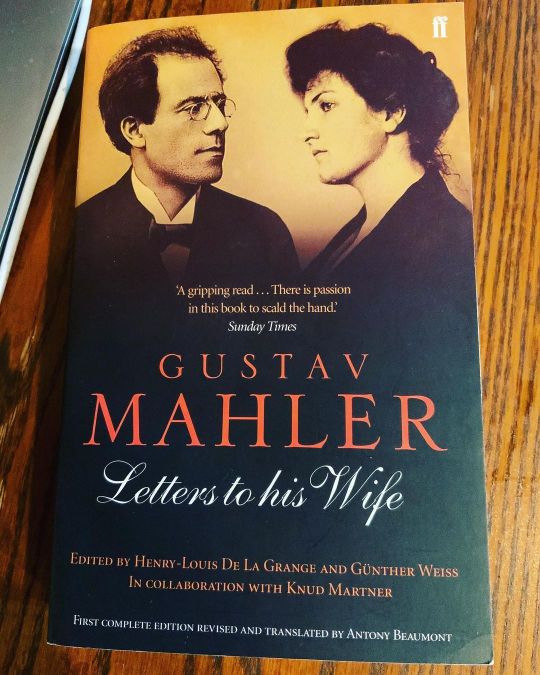#classicalcomposers
Explore tagged Tumblr posts
Text

Among the most intriguing superstitions linked to classical music is the “Curse of the Ninth,” which suggests that some of the most famous 19th-century composers died after writing their ninth symphony. This legend stems from a series of coincidences involving great musicians throughout history.
The myth originated with Ludwig van Beethoven, who passed away shortly after completing his Ninth Symphony, widely regarded as one of the greatest masterpieces in Western music. This work, considered the pinnacle of his artistic career, helped establish the belief that the ninth symphony represented a fatal limit for composers.
The legend gained further traction with the story of Gustav Mahler, an Austrian composer known for his superstition. Hoping to evade the curse, Mahler chose not to number one of his works after his Eighth Symphony, instead titling it “The Song of the Earth.” However, after completing his actual Ninth Symphony, he began working on the Tenth, which remained unfinished due to his death.
Other composers have also contributed to the legend, such as Franz Schubert, who died at just 31 years old, Louis Spohr, a pioneer in orchestral conducting, and Antonín Dvořák, whose Ninth Symphony became famous as the soundtrack for the first moon landing. These and other examples have perpetuated the mystique surrounding the “Curse of the Ninth.”
#CurseOfTheNinth#NinthSymphony#ClassicalMusicLegends#Beethoven#Mahler#MusicalSuperstitions#MusicHistory#ComposerStories#NinthSymphonyMyth#GustavMahler#FranzSchubert#AntoninDvorak#MusicMistery#MusicLore#ClassicalComposers#FamousComposers#ClassicalMusicFacts#MusicLegends#MusicSuperstition#CursedSymphony
3 notes
·
View notes
Text
Joseph Haydn Symphony No 52 In C Minor (1951)

Publication date 1951
Orchester Der Wiener Staatsoper
Anton Heiller Conductor
Joseph Haydn's Symphony No. 52 in C Minor, also known as "The Grand Symphony," is a masterpiece of the classical era. Composed in 1771, it is one of Haydn's lesser-known symphonies but holds immense artistic significance.
Symphony No. 52 opens with a captivating and dramatic introduction in the minor key, setting the tone for the entire piece. As the music unfolds, Haydn skillfully alternates between moments of tension and resolution, creating a sense of musical narrative that keeps the listener engaged throughout.
The first movement, marked Allegro assai, showcases Haydn's mastery of orchestration and his ability to create dynamic contrasts. The symphony is predominantly characterized by its energetic and lively themes, with the orchestra engaging in a lively dialogue. The development section explores various thematic variations, showcasing Haydn's inventive compositional techniques.
The second movement, marked Andante, provides a stark contrast to the preceding movement. Here, Haydn demonstrates his unparalleled ability to evoke deep emotions through music. The slow tempo and lyrical melodies create a sense of introspection and introspection. The orchestration is delicate, with the strings taking center stage and weaving a melancholic tapestry of sound.
The third movement, marked Menuetto: Allegro, brings a sense of playfulness and charm to the symphony. Haydn's use of syncopation and rhythmic interplay adds a delightful touch to this movement, making it a joyful and spirited dance. The minuet is followed by a contrasting Trio section, which provides a moment of respite before returning to the lively minuet.
The finale, marked Presto, brings the symphony to a thrilling conclusion. Haydn's use of rapid-fire melodies, intricate counterpoint, and vibrant orchestration create a sense of exhilaration and intensity. The music builds up to a grand and triumphant finale, leaving the audience in awe of Haydn's compositional brilliance.
Haydn's Symphony No. 52 in C Minor is a testament to the composer's creativity and innovation. Through its dramatic intensity, emotional depth, and technical brilliance, this symphony showcases Haydn's mastery of the classical form. Despite being overshadowed by some of his more famous works, Symphony No. 52 stands as a testament to Haydn's genius and deserves recognition for its significant contributions to classical music.
In conclusion, Joseph Haydn's Symphony No. 52 in C Minor is a captivating musical composition that showcases the composer's mastery of orchestration, inventive compositional techniques, and ability to evoke a wide range of emotions. Its combination of dramatic intensity, lyrical beauty, and technical brilliance make it a true gem of the classical era.
#ClassicalMusic#JosephHaydn#SymphonyNo52#CMajor#MusicalComposition#OrchestralMusic#ClassicalEra#HaydnSymphonies#ClassicalComposers#MusicAppreciation
0 notes
Text
Pol Plancon (Bass) - Cantique de Noel (Adam) (1906)
Pol Plançon sings 'Cantique de Noel,' recorded by Victor in New York on 23 January 1906.
Pol Henri Plançon (12 June 1851 – 11 August 1914) was a French operatic bass (basse chantante). He was one of the most acclaimed singers active during the 1880s, 1890s and early 20th century—a period often referred to as the 'Golden Age of Opera.'
In addition to being among the earliest international opera stars to have made recordings, he was a versatile singer who performed roles ranging from Sarastro in Mozart's The Magic Flute to the core bass roles by Meyerbeer, Gounod, Verdi and Wagner, among others.
He was renowned for his legato singing as well as for his diction, tone, intonation, and mastery of ornaments and fioriture.
“O Holy Night” (“Cantique de Noël”) is a well-known Christmas carol composed by Adolphe Adam in 1847 to the French poem “Minuit, chrétiens” by Placide Cappeau (1808-1877), a wine merchant and poet. Cappeau was asked to write a Christmas poem by a parish priest. It has become a standard modern carol for solo performance with an operatic finish.
In the carol, the singer recalls the birth of Jesus. It was translated into English by Unitarian minister John Sullivan Dwight, editor of Dwight's Journal of Music in 1855, and lyrics also exist in other languages.
On 24 December 1906, Reginald Fessenden, a Canadian inventor, broadcast the first AM radio program, which included him playing “O Holy Night” on the violin. The carol therefore appears to have been the first piece of music to be broadcast on radio. It later appeared in an edition of carols by Josiah Armes, published by Oxford in 1936, subsequently increasing its popularity.
#classical music#opera#music history#bel canto#composer#aria#classical composer#classical studies#maestro#chest voice#classicalmusic#musichistory#belcanto#classicalcomposer#classicalstudies#chestvoice#classicalmusician#classicalmusicians#classicalhistory#historianofmusic#historyofmusic#musician#musicians#diva#primadonna#PolPlancon#bass#CantiquedeNoel#CantiquedeNoël#OHolyNight
5 notes
·
View notes
Photo

Joseph Haydn, known as the 'Father of the Symphony,' made significant contributions to classical music in the 18th century. His works laid the foundation for future composers and reflected a buoyant, optimistic spirit amidst the emerging classical era. Fellow of the Viennese court, he fostered collaboration between musicians and shaped the symphonic form.. Visit www.OTONGO.net for more information.
#ComposerLife#MusicWisdom#AuthenticVoice#ClassicalInspiration#OTONGO#CreativityUnleashed#SymphonicJourney#HistoricalHarmony#OriginalityMatters#MusicalLegacy#VienneseCulture#MusicAndLife#TrueEssence#InspireAndConnect#ArtOfCommunication#HarmonyInExpression#ClassicalComposer#WisdomOfTheMasters#EchoesOfThePast#PassionForMusic
0 notes
Link
#BalletMusic#ClassicalComposer#classicalmusic#HistoricScore#Mendelssohn#mendelssohnhaus#midsummernightsdreamnyc#MusicHistory#Openingnight.Reviews#OrchestralMusic#TimelessMasterpiece
0 notes
Text
Schubert Trio is on the THE FRIDGE EP1 (DIGITAL EP) 2012 LYS 023
#classical#classicalmusic#classicalguitar#classicalmusician#classicalart#classicalmusicmode#classicalpianist#classicalpilates#classicalpiano#classicalballet#classicalbum#classicalguitarist#classicalarchitecture#classicaldance#classicalpianomusic#classicalpianocovers#classicalcrossover#classicalcomposer#classicalmusiccover#classicalrealism#classicalmusicians#classicalbums#classicaleducation#classicalconversations#classicallytrained#classicaldressage#classicalsinger#classicalstudies#classicalpainting#classicalsculpture
0 notes
Video
youtube
Lewis Gill: Inside the Mind of a Modern Classical Composer | Our Mind on Music Podcast https://youtu.be/Z_RLP-UUAYA?si=MmiKLh_ZP2Jrr30c YouTube #lewisgill #classicalcomposer #creativeprocess muz4now #drawingdrumming #CanFilmFest
0 notes
Video
youtube
An Immigrant in New York - Introduction
FYC!
With this album, a real life story, I wanted to put a name to one of those millions of nameless immigrants, who were able to achieve their dream for freedom, and along the way helped others achieve theirs too.
The album could not have been done without the creative force of the following musicians, thank you, you've been Amazing!
Violin & Viola: Konstantin Dimitrov
Cello: Tess Remy-Schumacher
Flute: Emma Koi
Clarinet: Seok Hee
Oboe: Jamie Strefeler
Piano: Kitt Wakeley
Saxophone: Suzanne Grzanna
Acoustic Guitar: Van Galen
Kaval: Angel Zhekov
Percussion: Ferenc Nemeth
Sound engineers:
Sax tracks: Mason Mazziotti
Cello tracks: Christina Giacona,
Patrick Conlon
Orchestration: Roumi Petrova
Mixing, Mastering: John Valeri
Winner of the “Osella Award” - International Venice Film Festival, Italy.
Digital Media: dimitrik.hearnow.com/an-immigrant-in-new-york
#fyc #grammys #classicalmusic #classicalcomposer #newagemusic #contemporarymusic #DimitriK. #LiteLoungeWithDimitriK.
0 notes
Text
i listen to classical music, and yes, sometimes i do feel better than other people.
7 notes
·
View notes
Text
Starting off with a bang

34 notes
·
View notes
Video
youtube
Enjoy the works of Carl Philipp Emanuel Bach’s Harpsichord Concerto in D Minor, with Mahan Esfahani at the harpsichord.
For fans of CPE Bach, I highly recommend reading Stephen L. Clark’s translation of CPE Bach’s letters. The son of JS Bach was a fascinating figure, and one of the most important composers during the transition from Baroque to Classical styles.
#carl philipp emanuel bach#cpe bach#harpsichord#harpsichord concerto#mahan esfahani#harpsichordist#bach#bach sons#daily bach#musicblr#orchestra#classicalorchestra#classicalcomposers
2 notes
·
View notes
Text
Classical Composers MBTI
ISTJ: Johannes Brahms
ISFJ: Antonio Vivaldi
INFJ: Antonin Dvorak
INTJ: Niccolò Paganini
ISTP: Steve Reich
ISFP: Claude Debussy
INFP: Franz Schubert
INTP: Ludwig van Beethoven
ESTP: Wolfgang Amadeus Mozart
ESFP: Joseph Haydn
ENFP: Franz Liszt
ENTP: Richard Wagner
ESTJ: Arnold Schoenberg
ESFJ: Clara Schumann
ENFJ: George Frederic Handel
ENTJ: Johann Sebastian Bach
2 notes
·
View notes
Text
Joseph Haydn Symphony No 56 In C Major (1951)

Publication date 1951
Orchester Der Wiener Staatsoper
Anton Heiller Conductor
Joseph Haydn's Symphony No. 56 in C Major is a delightful and vibrant composition that exemplifies the composer's genius and creativity. Written in 1774, this symphony is a testament to Haydn's mastery of the classical form and his ability to captivate listeners with his musical storytelling.
The symphony begins with an energetic and lively Allegro movement, immediately grabbing the attention of the audience. Haydn's use of contrasting themes and quick dynamic changes creates a sense of excitement and anticipation. The orchestra engages in a playful dialogue, with different sections of the ensemble exchanging musical ideas and motifs.
The second movement, marked Adagio, provides a contrast to the lively opening movement. It is characterized by its lyrical melodies and expressive harmonies. Haydn showcases his ability to create deep emotional impact through music, as the strings sing melancholic melodies while the woodwinds add delicate embellishments. The Adagio movement is a moment of introspection and reflection, allowing the listener to immerse themselves in the beauty of the music.
The symphony continues with a Menuetto movement, marked Allegretto. This movement brings a sense of charm and elegance to the composition. The dance-like rhythm and graceful melodies create a joyful and light-hearted atmosphere. Haydn's use of syncopation adds a touch of unpredictability and excitement to this movement, making it a delightful experience for both the performers and the audience.
The final movement, marked Prestissimo, brings the symphony to a thrilling conclusion. Haydn's virtuosic writing and intricate counterpoint are showcased in this fast-paced and exhilarating movement. The music builds up to a grand and triumphant finale, leaving the audience in awe of Haydn's compositional brilliance.
Symphony No. 56 in C Major is a testament to Haydn's ability to create engaging musical narratives. Through his creative use of thematic development, dynamic contrasts, and inventive orchestration, Haydn takes the listener on a journey filled with excitement, beauty, and emotional depth. The symphony's joyful character, combined with Haydn's technical mastery, makes it a true gem of the classical era.
In conclusion, Joseph Haydn's Symphony No. 56 in C Major is a captivating musical composition that showcases the composer's genius and creativity. Its combination of energetic movements, expressive melodies, and masterful orchestration make it a delightful listening experience. Symphony No. 56 is a testament to Haydn's significant contributions to classical music and serves as a reminder of his artistic brilliance.
#ClassicalMusic#JosephHaydn#SymphonyNo526#MusicalComposition#OrchestralMusic#ClassicalEra#HaydnSymphonies#ClassicalComposers#MusicAppreciation
0 notes
Photo

Picked up this #interestingbook of #collectedletters of #gustavmahler for #2bucks at the #arlingtonva #centrallibrary yesterday! #musichistory #booksaboutmusic #booksaboutmusicians #classicalcomposers #mahler #orchestramusic #orchestramusician #orchestraconductor #almamahler #germanromanticism #romanticcomposer #orchestra #symphonicmusic #musicnerd #classicalmusicianlife #classicalmusiclover #classicalmusicdaily #classicaliscool #musicappreciation (at Arlington VA Public Library) https://www.instagram.com/p/Cb4-IntLG4v/?utm_medium=tumblr
#interestingbook#collectedletters#gustavmahler#2bucks#arlingtonva#centrallibrary#musichistory#booksaboutmusic#booksaboutmusicians#classicalcomposers#mahler#orchestramusic#orchestramusician#orchestraconductor#almamahler#germanromanticism#romanticcomposer#orchestra#symphonicmusic#musicnerd#classicalmusicianlife#classicalmusiclover#classicalmusicdaily#classicaliscool#musicappreciation
1 note
·
View note
Video
instagram
Ludwig Van #beethoven “Farewell To The Piano” from my classical album of 22 famous pieces. This album is dedicated to my Dad’s mother (Grandma Newhall) who died in a tragic car accident in Los Angeles when I was very very young. I was gifted her 2 beautifully bound hardcover Piano books by my aunts. I decided to record some of her favorite pieces. This is a snip of the last little gem on the album. For the whole album search my name on #amazon and #itunes. #classicalcomposers #classicalmusic #dedicated #grandmother #piano #pianosolo #chopin #gounod #bach #cui #handel #instamusic
#cui#dedicated#beethoven#classicalmusic#itunes#classicalcomposers#amazon#piano#bach#pianosolo#handel#grandmother#instamusic#chopin#gounod
4 notes
·
View notes
Photo

New antique book in my shop: Germany’s Famous Composers. Printed in 1893 by the Oliver Dotson Co.-Boston MA . . #antiquebook #germancomposers #19thcenturybook #firstedition #alicemaudeallen #musiclibrary #biographies #bach #handel #hadyn #mozart #beethoven #schubert #mendelsshon #mendelshhonbartholdy #schumann #wagner #classicalcomposers #classicalmusic #classicalmusician #classicalmusicians https://www.instagram.com/p/CM_Iy3tparY/?igshid=oiezt533zss
#antiquebook#germancomposers#19thcenturybook#firstedition#alicemaudeallen#musiclibrary#biographies#bach#handel#hadyn#mozart#beethoven#schubert#mendelsshon#mendelshhonbartholdy#schumann#wagner#classicalcomposers#classicalmusic#classicalmusician#classicalmusicians
0 notes